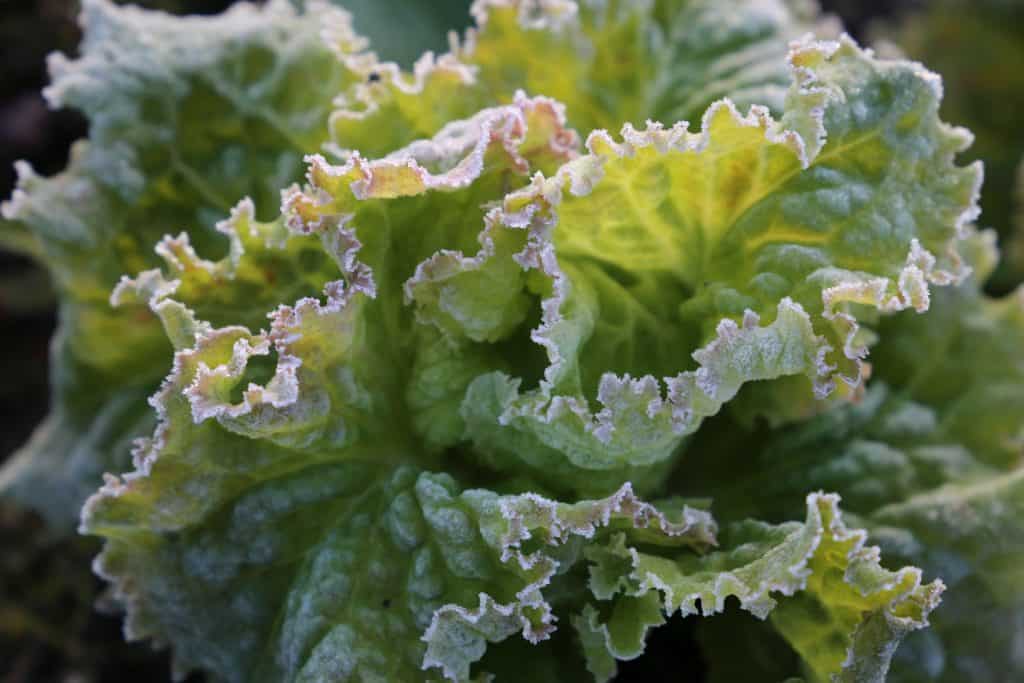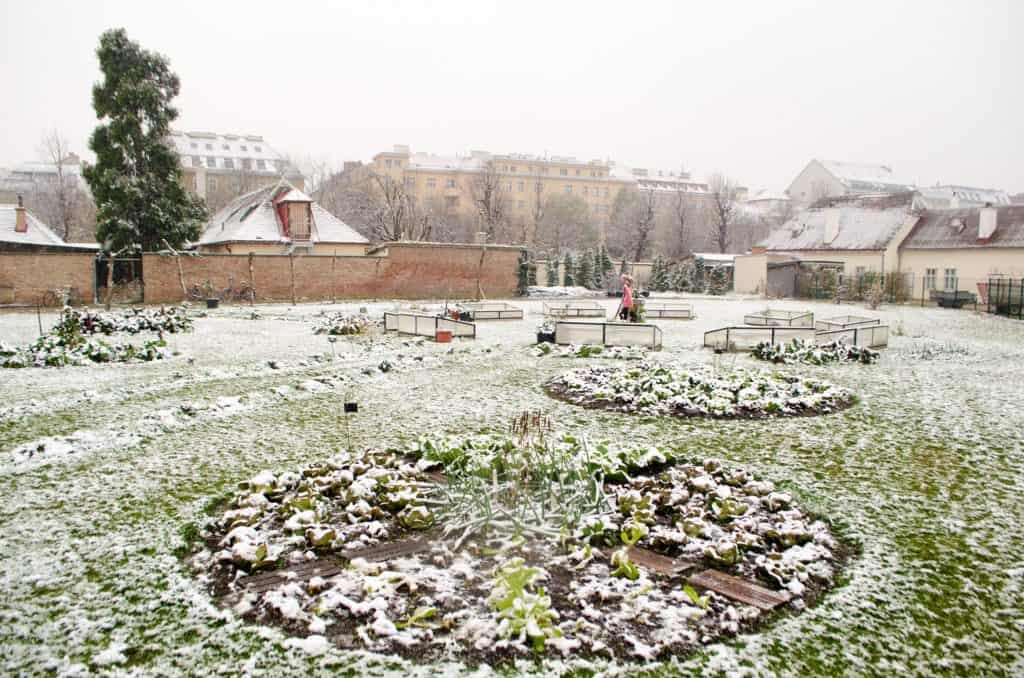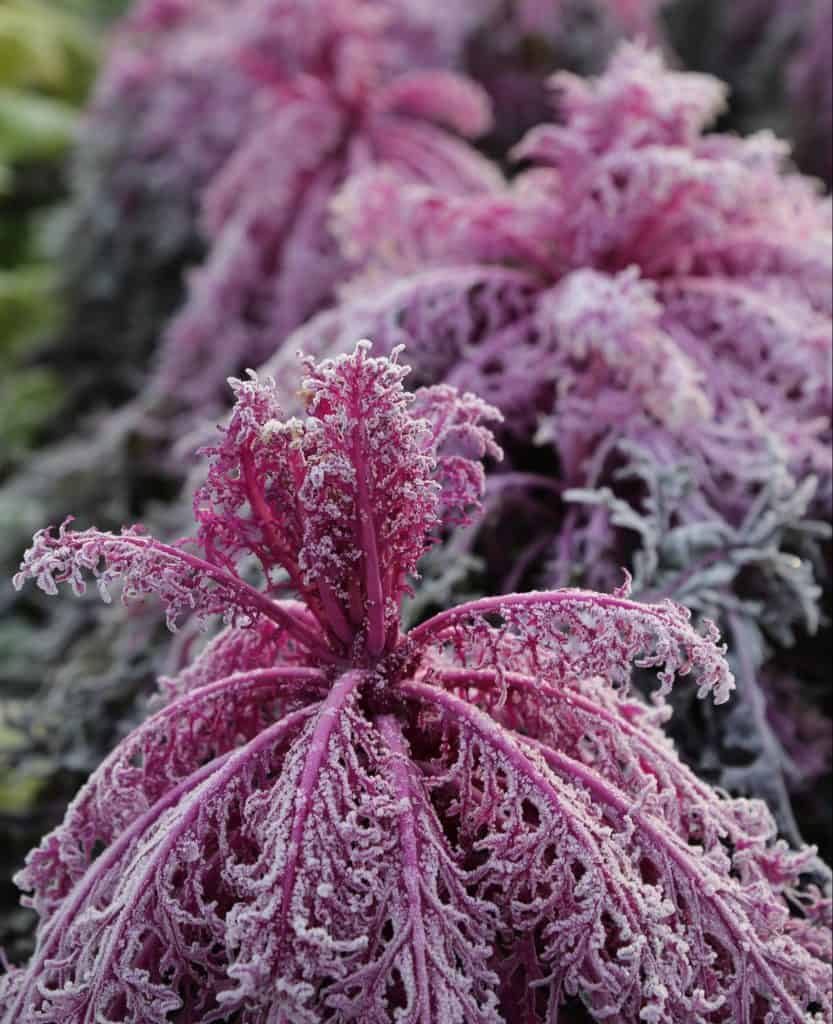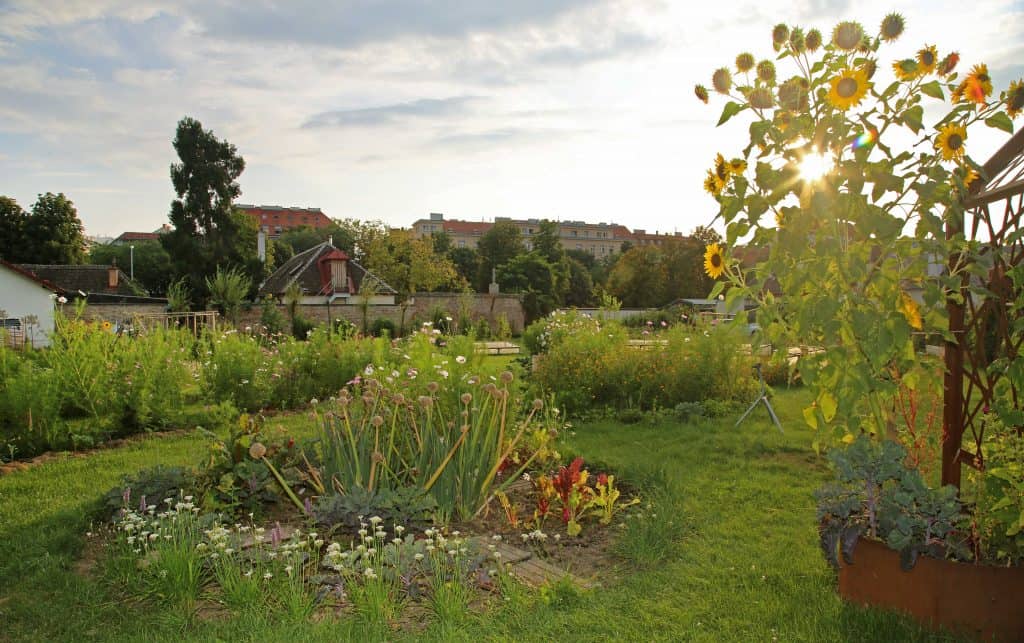It’s a frigid day in Lower Austria, a region famous for farming, but where pale fields lie fallow for the winter. The gray mountains of the Alps stand snow tipped on the horizon. In front of them, leafless trees brace themselves in the icy wind.
But the vegetable field behind Wolfgang Palme is alive with a painter’s palette of color: the deep violet leaves and scarlet stems of Swiss chard; the delicate green and chartreuse tips of leeks and winter endives; the Bordeaux red of beet tops and radicchio.

The tall scientist crouches down. With a pocket knife he trims some shoots of a flower sprout and cuts them in half. “They’re still very fresh and crunchy,” he says, popping one into his mouth. In fact, the small, posy-like leafy vegetable — a cross between a brussel sprout and kale — tastes nutty and elegant.
Palme and his team planted the flower sprouts in late summer. Now it is the end of February. Spinach, purslane, radish, turnips, mediterranean herbs and lacinato kale have also survived the winter on the farm undamaged despite temperatures far below zero. Nearby, in large, unheated soft-plastic tunnels, even delicate salad greens, carrots, celery and pea sprouts are thriving in what should be impossible conditions. But to Palme, an agronomist and the head of the Research Institute of Horticulture in Austria, this jolting image isn’t just possible — it is the future of farming.

Year round, but especially in winter, most people in Central Europe eat vegetables transported from afar: from southern European countries like Spain and Italy, but also from distant countries like Brazil, Peru and India. What is available locally is typically grown in heated greenhouses. Both methods are environmentally problematic.
According to a study by the World Wildlife Fund of Switzerland, a kilogram of asparagus flown in from Peru results in 15 kilograms of CO2 emissions, compared to less than one kilogram of CO2 if it has been cultivated in Switzerland. Green beans coming from Morocco generate more than three kilograms of CO2 compared to the 100 grams locally grown beans would produce. It makes no difference whether these goods come from organic or conventional agriculture, as most of the emissions stem from transport, packaging and provision.
Even the trend toward local and regional food only helps to a limited extent when there is frost outside. A tomato from a heated greenhouse is guilty of ten times the CO2 emissions of one grown in the field, says a study from the Institute for Energy and Environmental Research Heidelberg.
“In a cold winter night, a heated greenhouse of 1.5 acres causes as much CO2 equivalent as a detached house in a whole year,” says Palme. “Mankind can no longer afford this.”

Enter Palme’s research on the Zinsenhof, the experimental farm where he guides me through frosty rows of seemingly implausible crops, and where he and his team have been perfecting the year-round cultivation of vegetables in the open field or in unheated soft-plastic tunnels for over ten years. There, they have developed methods to produce lettuce, spinach, scallions and red radishes in the dead of winter with one-sixth to one-tenth the carbon footprint of fresh produce farmed in heated systems.
Like many of the best discoveries, Palme came upon the possibility of winter vegetable farming by chance when an experiment involving Asian salad greens was interrupted by an early and unexpected frost. Despite a temperature of minus 11 degrees Celsius, they remained undamaged. The technical literature had stated a frost hardiness of only minus three to five degrees. “Fortunately, these lettuces had not read the literature,” he says.
Wolfgang Palme followed the trail and found that many of the frost hardiness numbers stated in the technical literature were not correct. So he redefined them and began re-writing literature around winter farming in Central Europe. So far, Palme has identified more than 70 varieties that can stand the region’s winter temperatures.
Read about the vegetables you can grow using Palme’s techniques
One hint to how vegetables survive cold weather lies in the taste: Many vegetables form a kind of frost protection in their cells made of sugar, which explains the sweet taste of, say, the roots and tubers that we traditionally think of as winter vegetables. If they did not form this protection, the cells would burst at sub-zero temperatures because the water inside them expands when it freezes.
That means that those vegetables that don’t have this protection mechanism, like salad greens or tomatoes, need a little extra help. But it turns out, not quite as much help as we might think. In the 19th century, market gardeners in France and Great Britain cultivated vegetables in winter by keeping their garden beds warm with dung, something Palme is also experimenting with alongside his plastic tunnels. With the combination of new and old methods, he was able to produce high yields of tomatoes in unheated tunnels until well into November.
Crushed by negative news?
Sign up for the Reasons to be Cheerful newsletter.In addition to frost hardiness, Palme is researching the right time to sow seeds, looking for the perfect balance of soon enough (to enable the vegetables to develop sufficient root systems and take in enough sun from late summer and autumn), but not too soon (to make sure the summer crops can come to full fruition and make maximum use of valuable space). As Palme puts it poetically: “Autumn is the spring of winter.”
Palme wants to provide practical knowledge, which is why, along with the Institute’s three research stations, he collaborated with seven vegetable farms from different climatic regions in Austria between 2016 and 2019 to observe his methods applied. But the research also focused on the socio-economic aspects of winter cultivation.
“Winter vegetables are good for small and medium-sized farmers,” says Palme. They allow farmers to use land year round, save energy and expand their product range. It also gives products a narrative: one about the changing seasons and sustainable management — something that is becoming increasingly important to customers.
One of the farms employing Palme’s tactics is the Krautwerk in the Lower Austrian village of Großmugl, run by Claudia Detz and Robert Brodnjak, a couple originally from Vienna. Detz worked there as an accountant, and Brodnjak as an IT specialist. In a leap of faith in their market garden, where they grow 200 varieties of vegetables on only 3.5 acres (a little less than three football fields), they dared to leave their day jobs and become full time farmers. At their weekly stand in the Viennese Carmelite Market, the two sell 600 kilograms of vegetables in just a few hours. Krautwerk also supplies ten restaurants in Vienna, including the Michelin-rated Steirereck, recently ranked one of the top 50 restaurants in the world.
Detz says that a wide variety of customers come to them seeking something close to home, and willing to pay a premium. “Our customers have a high regard for food and they are willing to pay extra for sustainable production,” she says, pulling her hood close around her face. The bitter wind of the morning has been followed by equally frigid rain, and drops trickle down onto the tunnel where Robert Brodnjak is planting portulaca and pak choi.

The career changers have found their niche with their winter crops. The range of their ten varieties of winter vegetables complements their summer crops, providing extra winter income and enticing new customers. Soon they’ll expand to include new winter options, including chard, beets and lettuce. They have low costs and profitable direct marketing. They also have a sophisticated space-management system aided by planning software from the U.S., which they discovered at the Young Farmers Conference in New York, an annual meeting of small market gardeners who are primarily interested in sustainable cultivation and consumption.
Palme wants the practice of winter farming to grow, and to enjoy increased awareness throughout Austrian society. To that end, he has founded the City Farm in Vienna. In the centrally located Augarten, the largest park in the city, a variety of winter vegetables grow just as colorful as in the Zinsenhof. Workshops are held here almost daily and school classes tend their own beds. “You can’t start early enough,” says Palme, and suddenly, as if on command, the bright voices of the world-renowned Vienna Boys’ Choir begin wafting over the garden from the nearby Augartenpalais, where the choir lives and rehearses. I ask Palme: Do their voices make the winter vegetables grow faster? He grins: “We haven’t researched that yet.”






